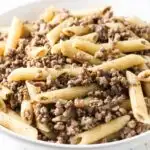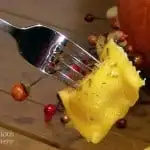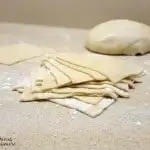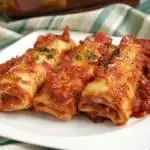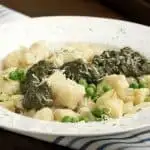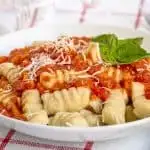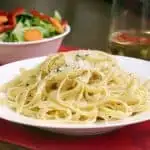These homemade tubular pasta, Žrnovski Makaruni, are a traditional recipe from a small town on Korčula, one of Croatia’s southern islands. Hand rolling these noodles takes a bit of time and is a great activity to get the whole family involved in.
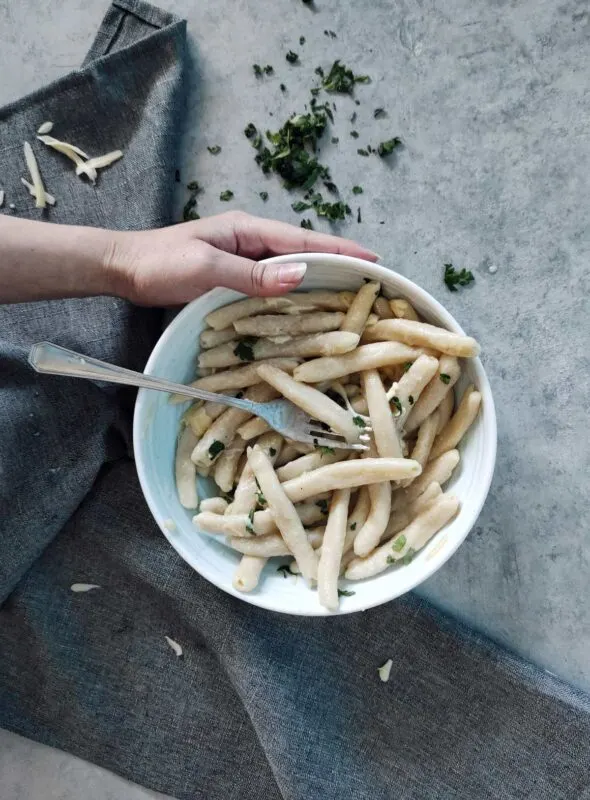
Homemade pasta in Croatia
In Croatia, homemade pasta plays a big role in the gastronomic scene, and it is one of the main ingredients of Croatian traditional cuisine. Due to that, almost every region has its own traditional, local pasta.
The smaller region of Zagorje, in the northern part of Croatia, has mlinci.
The region of Slavonia in the north eastern part of Croatia is known for its wide and narrow noodles for homemade soup (and you can tell quite easily which noodles are bought in the store and which are homemade).
The most famous Croatian region when it comes to pasta is the peninsula of Istria, where there are numerous types of pasta such as pasutice, lazanje, fidelini, ravijoli, makaruni, rigationi, fuži, pljukanci, and more.
Yes, Istria is quite famous for its cuisine and homemade pasta, but let’s move further down the Croatian coast to the region of Dalmatia.
Besides the most common pasta types which can be found throughout the entire coast, such as spaghetti and gnocchi, once you get to the southern part of the region and start island hopping, there is one specific island with amazingly delicious (and attractive looking) pasta.
On the island of Korčula, there is one small village where you find a local pasta called žrnovski makaruni.
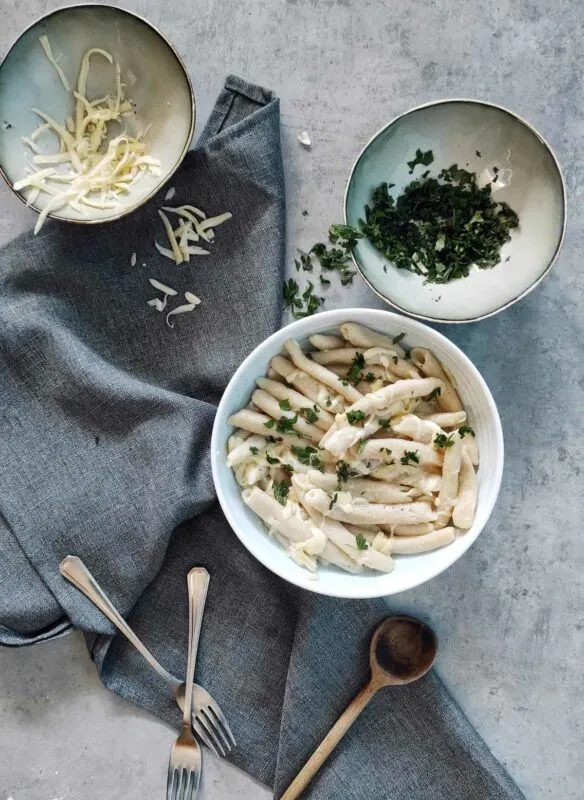
Island of Korčula
Korčula is a beautiful island located in the southern part of Croatia.
It is the sixth-largest island in Croatia, and it is known for its dense forest. Due to that, the ancient Greeks called the island Kerkyra Melaina which means “black Korčula”.
This island has beautiful and breathtaking views, and it offers small and traditional-like towns and villages that are dotted around the island; perfect for exploring and meeting local life.
While wandering through the island and villages, you can feel the peace and quietness, and indulge in picturesque views and fjaka state of mind.
(Fjaka is a psychophysical state when striving for nothing. But don’t confuse it for laziness, it is a state of mind and body which all mankind aspires. In Dalmatia, fjaka is simply a gift from God).
Olive oil and wine traditions of Korčula
Besides all mentioned already, Korčula is known for its beautiful traditions.
The olive oil made on the island is well known and recognized due to its unique characteristics and high quality. The reasons for such a quality combine components of the weather, long historical heritage, and a wide range of factors.
Olive oil from Korčula is famous for its piquant and bitter flavors with a touch of olive leaves, aromatic herbs, and green fruits.
The other tradition of the island is winemaking. Korčula has a millennial tradition of making fine wines.
Unlike the rest of Dalmatia, which is known for red wines, Korčula offers interesting white wines from indigenous grape varieties such as Pošip, Rukatac, and Grk.
Thanks to the combination of great geographical components, suitable climate, and soil, the wines of the island have beautiful personality and complexity with a touch of accentuated aromas and extremely fine acids.
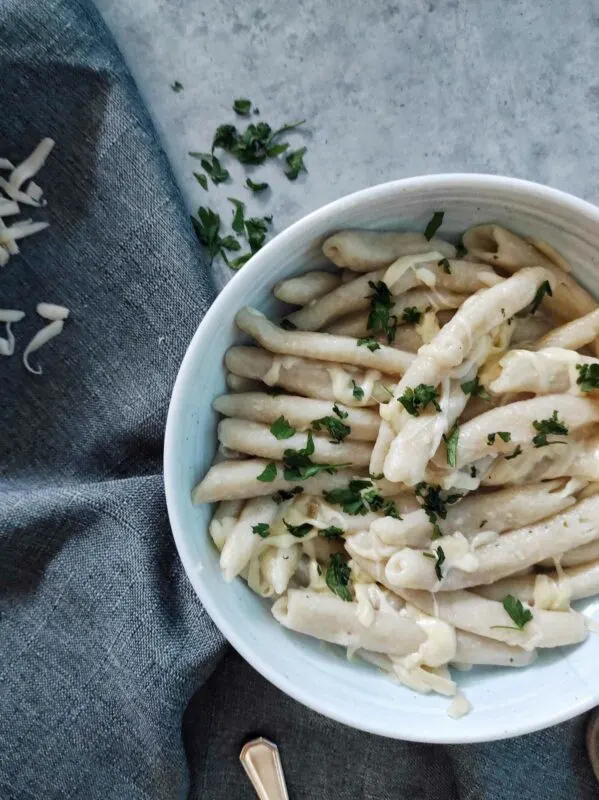
The cuisine of Korčula
And now, we come to the most important tradition of the island – cuisine.
Life on the island has always been modest, but despite that, its inhabitants developed a delicious and varied cuisine that adapted according to the material possibilities and accessible ingredients.
Vegetables, fruit, fish, and other simple ingredients were the main components in preparing a variety of delicious dishes and meals.
Today, Korčula is known for simple but rich-in-flavors dishes such as fish brodet, fried grits, lumblija, dried figs, kotonjata, and more.
When it comes to pasta, žrnovski makaruni are the trademark of the island.
Ancient Recipe of Korčula’s Housewives
Now that we’ve talked about the island and its famous traditions, it is time to talk about the tradition of the recipe for žrnovski makaruni!
Žrnovski makaruni (zrn-ov-skhi ma-kha-runi) come from from a small village on the island of Korčula called Žrnovo.
They present medium-size tubular pasta with a small hole in the middle.
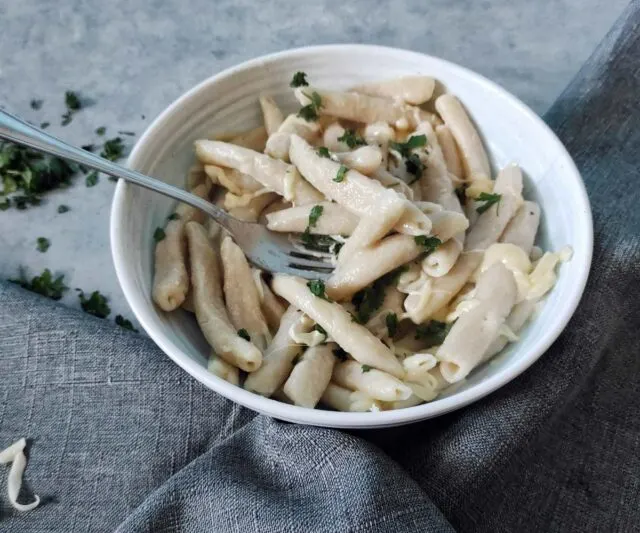
Even though there is a common opinion that Marco Polo brought macaroni from China, the usage of ground wheat (known as flour) and water has been known on the island of Korčula since ancient times.
In the past, makaruni were made only for special occasions and festivities, and as it is already mentioned, they were mostly prepared in Žrnovo from where they spread all over the island.
Every little girl in every household had to know how to prepare makaruni, and the recipe was carried on from one generation to the other.
What makes makaruni special, is that each piece of the dough is placed on a thin skewer and then rolled between the palms of the hands – and that’s the way each makarun (and there are a lot of them) is made.
How to serve Žrnovski makaruni
Žrnovski makaruni can be prepared with classic beef mange, prawns, tomato sauce, pesto (sauce made of fresh basil), different types of meat, seafood, and more.
Since 2008, Žrnovo organizes an annual festival called Žrnovska makarunada. At the festival, inhabitants prepare thousands of portions of makaruni with beef mange. In addition, tourists can join the workshop to learn how to prepare this traditional pasta!
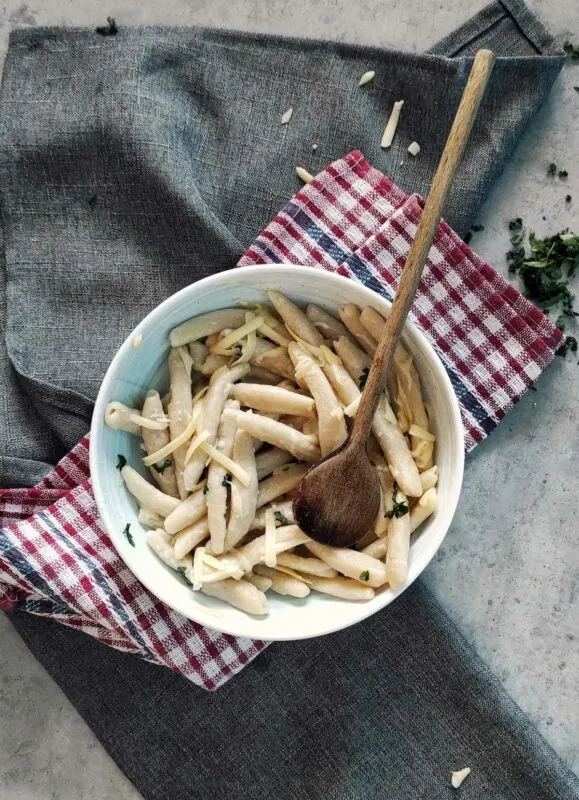
Tips and tricks for preparing homemade pasta
The dough for žrnovski makaruni is made according to the classic and simple recipe. You just need a couple of ingredients such as pastry flour, water, olive oil, egg yolk, and a bit of salt.
The dough needs to be well-kneaded and then left to rest for half an hour. While resting, the dough needs to be wrapped in plastic wrap to stay moist.
For making makaruni, you need a thin skewer. It can be wooden or metal. When putting the skewer on the dough, make sure you put it on the floured side, not the cut side without the flour. If the dough does stick to the skewer, just put a bit of flour on the skewer and you’re good to go.
The key to making this pasta is rolling each makarun between the palm of your hands. This takes time and your palms might get itchy from the action of rolling (mine did and I was annoyed but let me tell you, it was worth it in the end!) so if they do, take a break and put a bit of warm water on your palms so they get used to the warmth.
To freeze homemade pasta for later
If you want to freeze the makaruni, flour them and let them dry for a bit. Then, lay them on baking paper on a flat tray. Cover them with plastic wrap and put them into the freezer. When they are frozen (after an hour or so), place makaruni into a freezer bag and put them into a freezer. That’s it!
Now, let’s prepare žrnovski makaruni and serve them with cheese and fresh parsley!
Žrnovski Makaruni (Homemade Pasta from Korčula Croatia)
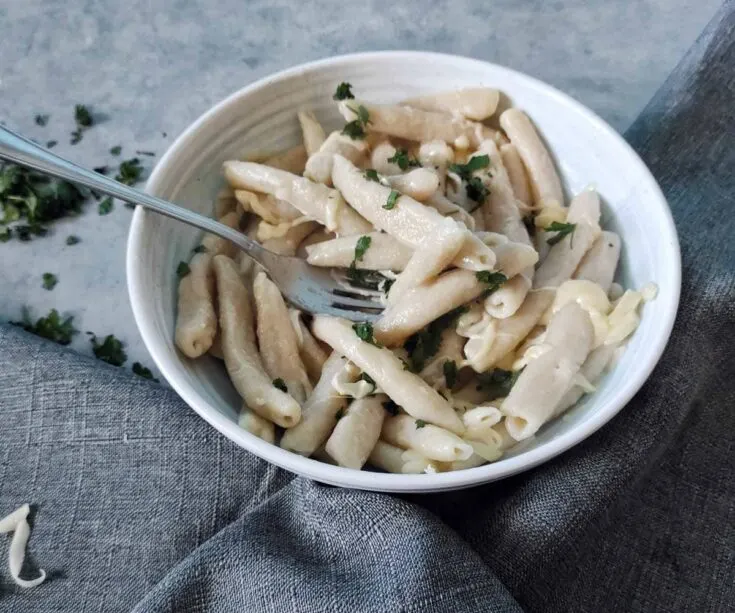
These homemade tubular pasta, Žrnovski Makaruni, are a traditional recipe from a small town on Korčula, one of Croatia's southern islands. Hand rolling these noodles takes a bit of time and is a great activity to get the whole family involved in.
Ingredients
- 4 3/4 cups (1.10 lb) pastry flour
- 1 egg yolk
- 1/4 cup (50 ml) olive oil
- 1 cup (250 ml) boiling water
- 1/2 teaspoon salt
- grated cheese, to top (ex: gouda)
- fresh parsley, to top
- Also needed - thin wooden or metal skewer - to shape the pasta
Instructions
- In a large bowl, mix flour, salt, and boiling water with a wooden spoon.
- Once the mixture has cooled enough to touch, add the egg yolk and knead with your hands until you get a firm dough.
- Turn the dough out onto a floured surface and knead a couple more minutes, until smooth.
- Wrap the dough in plastic wrap and let it rest for half an hour.
- After resting, divide the dough into 10 smaller pieces. Roll each piece into a long rope. Cover the ropes with the plastic wrap while you are working with one.
- One at a time, dust a rope with flour and cut it into small pieces (the size of a cherry).
- Take one of the small pieces and place the floured side on the skewer. Using the palms of your hands, roll the dough around the skewer, connecting the dough and rolling it thinly, to create a tube. Remove the skewer and repeat this rolling method with all of the dough. (If the skewer beings to stick to the dough, dust it with some flour.)
- Cook the makaruni in boiling, salted water for 10 to 15 minutes (the cooking time depends on the thickness of the pasta).
- While the pasta is cooking, grate the cheese and chop the parsley.
- Serve žrnovski makaruni hot, topped with cheese and parsley.
Notes
If you want to freeze the makaruni, flour them and let them dry for a bit. Then, lay them on baking paper on a flat tray. Cover them with plastic wrap and put them into the freezer. When they are frozen (after an hour or so), place makaruni into a freezer bag and put them into a freezer.
Nutrition Information:
Yield:
4Serving Size:
1/4 of recipe (just pasta)Amount Per Serving: Calories: 640
If you liked this recipe, here are some similar dishes you may enjoy!

Ana has a bachelor’s degree in journalism, and she has received a Rector’s award for achievements during her studies. She is an experienced writer for restaurants and wineries, and she loves to cook, research, and experiment with different cuisines and ingredients. Besides writing, Ana loves to photograph and travel, especially to Korčula, Croatia which is her second home and the best inspiration for new recipes and flavors.
